SNOSAX9J April 2007 – April 2016 LMH6552
PRODUCTION DATA.
- 1 Features
- 2 Applications
- 3 Description
- 4 Revision History
- 5 Pin Configuration and Functions
- 6 Specifications
- 7 Detailed Description
-
8 Application and Implementation
- 8.1 Application Information
- 8.2 Typical Applications
- 9 Power Supply Recommendations
- 10Layout
- 11Device and Documentation Support
- 12Mechanical, Packaging, and Orderable Information
Package Options
Mechanical Data (Package|Pins)
Thermal pad, mechanical data (Package|Pins)
Orderable Information
6 Specifications
6.1 Absolute Maximum Ratings(1)(3)
| MIN | MAX | UNIT | |
|---|---|---|---|
| Supply Voltage | 13.2 | V | |
| Common Mode Input Voltage | ±VS | V | |
| Maximum Input Current (pins 1, 2, 7, 8) | 30 | mA | |
| Maximum Output Current (pins 4, 5) | (2) | mA | |
| Maximum Junction Temperature | 150 | °C | |
| Storage temperature, Tstg | −65 | 150 | °C |
(1) Stresses beyond those listed under Absolute Maximum Ratings may cause permanent damage to the device. These are stress ratings only, which do not imply functional operation of the device at these or any other conditions beyond those indicated under Recommended Operating Conditions. Exposure to absolute-maximum-rated conditions for extended periods may affect device reliability.
(2) The maximum output current (IOUT) is determined by device power dissipation limitations. See Power Dissipation for more details.
(3) For soldering specifications see SNOA549
6.2 ESD Ratings
| VALUE | UNIT | |||
|---|---|---|---|---|
| V(ESD) | Electrostatic discharge | Human-body model (HBM), per ANSI/ESDA/JEDEC JS-001(1) | ±2000 | V |
| Charged-device model (CDM), per JEDEC specification JESD22-C101(2) | ±750 | |||
| Machine model (MM) | ±250 | |||
(1) JEDEC document JEP155 states that 500-V HBM allows safe manufacturing with a standard ESD control process.
(2) JEDEC document JEP157 states that 250-V CDM allows safe manufacturing with a standard ESD control process.
6.3 Recommended Operating Conditions
| MIN | NOM | MAX | UNIT | |
|---|---|---|---|---|
| Operating Temperature Range (1) | −40 | +85 | °C | |
| Total Supply Voltage | 4.5 | 12 | V |
(1) The maximum power dissipation is a function of TJ(MAX), θJA. The maximum allowable power dissipation at any ambient temperature is PD = (TJ(MAX)– TA) / θJA. All numbers apply for packages soldered directly onto a PC Board.
6.4 Thermal Information
| THERMAL METRIC(1) | LMH6552 | UNIT | ||
|---|---|---|---|---|
| D | NGS | |||
| 8 PINS | 8 PINS | |||
| RθJA | Junction-to-ambient thermal resistance | 150 | 58 | °C/W |
(1) For more information about traditional and new thermal metrics, see the IC Package Thermal Metrics application report, SPRA953.
6.5 Electrical Characteristics: ±5 V
Unless otherwise specified, all limits are ensured for TA = 25°C, V+ = +5 V, V− = −5 V, AV= 1, VCM = 0 V, RF = RG = 357 Ω, RL = 500 Ω, for single ended in, differential out.(1)| PARAMETER | TEST CONDITIONS | MIN(4) | TYP(3) | MAX(4) | UNIT | |
|---|---|---|---|---|---|---|
| AC PERFORMANCE (DIFFERENTIAL) | ||||||
| SSBW | Small Signal −3-dB Bandwidth (4) | VOUT = 0.2 VPP, AV = 1, RL = 1 kΩ | 1500 | MHz | ||
| VOUT = 0.2 VPP, AV = 1 | 1000 | |||||
| VOUT = 0.2 VPP, AV = 2 | 930 | |||||
| VOUT = 0.2 VPP, AV = 4 | 810 | |||||
| VOUT = 0.2 VPP, AV = 8 | 590 | |||||
| LSBW | Large Signal −3 dB Bandwidth | VOUT = 2 VPP, AV = 1, RL = 1 kΩ | 1250 | MHz | ||
| VOUT = 2 VPP, AV = 1 | 950 | |||||
| VOUT = 2 VPP, AV = 2 | 820 | |||||
| VOUT = 2 VPP, AV = 4 | 740 | |||||
| VOUT = 2 VPP, AV = 8 | 590 | |||||
| 0.1-dB Bandwidth | VOUT = 0.2 VPP, AV = 1 | 450 | MHz | |||
| Slew Rate | 4-V Step, AV = 1 | 3800 | V/μs | |||
| Rise, Fall Time, 10%-90% | 2-V Step | 600 | ps | |||
| 0.1% Settling Time | 2-V Step | 10 | ns | |||
| Overdrive Recovery Time | VIN = 1.8-V to 0-V Step, AV = 5 V/V | 6 | ns | |||
| DISTORTION AND NOISE RESPONSE | ||||||
| HD2 | 2nd Harmonic Distortion | VOUT = 2 VPP, f = 20 MHz, RL = 800 Ω | –92 | dBc | ||
| VOUT = 2 VPP, f = 70 MHz, RL = 800 Ω | –74 | |||||
| HD3 | 3rd Harmonic Distortion | VOUT = 2 VPP, f = 20 MHz, RL = 800 Ω | –93 | dBc | ||
| VOUT = 2 VPP, f = 70 MHz, RL = 800 Ω | –84 | |||||
| IMD3 | Two-Tone Intermodulation | f ≥ 70 MHz, Third-Order Products, VOUT = 2-VPP Composite | –87 | dBc | ||
| Input Noise Voltage | f ≥ 1 MHz | 1.1 | nV/√Hz | |||
| Input Noise Current | f ≥ 1 MHz | 19.5 | pA/√Hz | |||
| Noise Figure (See Figure 46) | 50-Ω System, AV = 9, 10 MHz | 10.3 | dB | |||
| INPUT CHARACTERISTICS | ||||||
| IBI | Input Bias Current (6) | 60 | 110 | µA | ||
| IBoffset | Input Bias Current Differential (3) |
VCM = 0 V, VID = 0 V, IBoffset = (IB− - IB+)/2 | 2.5 | 18 | µA | |
| CMRR | Common Mode Rejection Ratio (3) | DC, VCM = 0 V, VID = 0 V | 80 | dBc | ||
| RIN | Input Resistance | Differential | 15 | Ω | ||
| CIN | Input Capacitance | Differential | 0.5 | pF | ||
| CMVR | Input Common Mode Voltage Range | CMRR > 38 dB | ±3.5 | ±3.8 | V | |
| OUTPUT PERFORMANCE | ||||||
| Output Voltage Swing (3) | Differential Output | 14.8 | 15.4 | VPP | ||
| IOUT | Linear Output Current (3) | VOUT = 0 V | ±70 | ±80 | mA | |
| ISC | Short Circuit Current | One Output Shorted to Ground VIN = 2 V Single Ended (2) | ±141 | mA | ||
| Output Balance Error | ΔVOUT Common Mode / ΔVOUT Differential, ΔVOD = 1 V, f < 1 MHz | –60 | dB | |||
| MISCELLANEOUS PERFORMANCE | ||||||
| ZT | Open Loop Transimpedance | Differential | 108 | dBΩ | ||
| PSRR | Power Supply Rejection Ratio | DC, (V+ - |V-|) = ±1 V | 80 | dB | ||
| IS | Supply Current (3) | RL = ∞ | 19 | 22.5 | 25 28 |
mA |
| Enable Voltage Threshold | 3 | V | ||||
| Disable Voltage Threshold | 2.0 | V | ||||
| Enable/Disable time | 15 | ns | ||||
| ISD | Disable Shutdown Current | 500 | 600 | μA | ||
| OUTPUT COMMON MODE CONTROL CIRCUIT | ||||||
| Common Mode Small Signal Bandwidth | VIN+ = VIN− = 0 | 400 | MHz | |||
| Slew Rate | VIN+ = VIN− = 0 | 607 | V/μs | |||
| VOSCM | Input Offset Voltage | Common Mode, VID = 0, VCM = 0 | 1.5 | ±16.5 | mV | |
| Input Bias Current | (5) | –3.2 | ±8 | µA | ||
| Voltage Range | ±3.7 | ±3.8 | V | |||
| CMRR | Measure VOD, VID = 0 V | 80 | dB | |||
| Input Resistance | 200 | kΩ | ||||
| Gain | ΔVO,CM / ΔVCM | 0.995 | 1.0 | 1.012 | V/V | |
(1) Electrical Table values apply only for factory testing conditions at the temperature indicated. Factory testing conditions result in very limited self-heating of the device such that TJ = TA. No specification of parametric performance is indicated in the electrical tables under conditions of internal self-heating where TJ > TA. See Overview for information on temperature de-rating of this device. Min/Max ratings are based on product characterization and simulation. Individual parameters are tested as noted.
(2) Limit short circuit current in duration to no more than 10 seconds. See Power Dissipation for more details.
(3) Typical values represent the most likely parametric norm as determined at the time of characterization. Actual typical values can vary over time and also depend on the application and configuration. The typical values are not tested and are not ensured on shipped production material.
(4) Limits are 100% production tested at 25°C. Limits over the operating temperature range are ensured through correlation using Statistical Quality Control (SQC) methods.
(5) Negative input current implies current flowing out of the device.
6.6 Electrical Characteristics: ±2.5 V
Unless otherwise specified, all limits are ensured for TA = 25°C, V+ = +2.5 V, V− = −2.5 V, AV = 1, VCM = 0 V, RF = RG = 357 Ω, RL = 500 Ω, for single ended in, differential out.(1)| PARAMETER | TEST CONDITIONS | MIN (4) | TYP (3) | MAX (4) | UNIT | |
|---|---|---|---|---|---|---|
| SSBW | Small Signal −3-dB Bandwidth (4) | VOUT = 0.2 VPP, AV = 1, RL = 1 kΩ | 1100 | MHz | ||
| VOUT = 0.2 VPP, AV = 1 | 800 | |||||
| VOUT = 0.2 VPP, AV = 2 | 740 | |||||
| VOUT = 0.2 VPP, AV = 4 | 660 | |||||
| VOUT = 0.2 VPP, AV = 8 | 498 | |||||
| LSBW | Large Signal −3 dB Bandwidth | VOUT = 2 VPP, AV = 1, RL = 1 kΩ | 820 | MHz | ||
| VOUT = 2 VPP, AV = 1 | 690 | |||||
| VOUT = 2 VPP, AV = 2 | 620 | |||||
| VOUT = 2 VPP, AV = 4 | 589 | |||||
| VOUT = 2 VPP, AV = 8 | 480 | |||||
| 0.1 dB Bandwidth | VOUT = 0.2 VPP, AV = 1 | 300 | MHz | |||
| Slew Rate | 2-V Step, AV = 1 | 2100 | V/μs | |||
| Rise/Fall Time, 10% to 90% | 2-V Step | 700 | ps | |||
| 0.1% Settling Time | 2-V Step | 10 | ns | |||
| Overdrive Recovery Time | VIN = 0.7-V to 0-V Step, AV = 5 V/V | 6 | ns | |||
| DISTORTION AND NOISE RESPONSE | ||||||
| HD2 | 2nd Harmonic Distortion | VOUT = 2 VPP, f = 20 MHz, RL = 800 Ω | -82 | dBc | ||
| VOUT = 2 VPP, f = 70 MHz, RL = 800 Ω | -65 | |||||
| HD3 | 3rd Harmonic Distortion | VOUT = 2 VPP, f = 20 MHz, RL = 800 Ω | -79 | dBc | ||
| VOUT = 2 VPP, f = 70 MHz, RL = 800 Ω | -67 | |||||
| IMD3 | Two-Tone Intermodulation | f ≥ 70 MHz, Third-Order Products, VOUT = 2-VPP Composite |
−77 | dBc | ||
| Input Noise Voltage | f ≥ 1 MHz | 1.1 | nV/√Hz | |||
| Input Noise Current | f ≥ 1 MHz | 19.5 | pA/√Hz | |||
| Noise Figure (See Figure 46) | 50-Ω System, AV = 9, 10 MHz | 10.2 | dB | |||
| INPUT CHARACTERISTICS | ||||||
| IBI | Input Bias Current (6) | 54 | 90 | µA | ||
| IBoffset | Input Bias Current Differential (3) |
VCM = 0 V, VID = 0 V, IBoffset = (IB− - IB+ )/2 | 2.3 | 18 | μA | |
| CMRR | Common-Mode Rejection Ratio (3) | DC, VCM = 0 V, VID = 0 V | 75 | dBc | ||
| RIN | Input Resistance | Differential | 15 | Ω | ||
| CIN | Input Capacitance | Differential | 0.5 | pF | ||
| CMVR | Input Common Mode Range | CMRR > 38 dB | ±1.0 | ±1.3 | V | |
| OUTPUT PERFORMANCE | ||||||
| Output Voltage Swing (3) | Differential Output | 5.6 | 6.0 | VPP | ||
| IOUT | Linear Output Current (3) | VOUT = 0 V | ±55 | ±65 | mA | |
| ISC | Short Circuit Current | One Output Shorted to Ground, VIN = 2 V Single Ended (2) | ±131 | mA | ||
| Output Balance Error | ΔVOUT Common Mode / ΔVOUT Differential, ΔVOD = 1 V, f < 1 MHz | 60 | dB | |||
| MISCELLANEOUS PERFORMANCE | ||||||
| ZT | Open Loop Transimpedance | Differential | 107 | dBΩ | ||
| PSRR | Power Supply Rejection Ratio | DC, ΔVS = ±1 V | 80 | dB | ||
| IS | Supply Current (3) | RL = ∞ | 17 | 20.4 | 24 27 |
mA |
| Enable Voltage Threshold | 0.5 | V | ||||
| Disable Voltage Threshold | –0.5 | V | ||||
| Enable/Disable Time | 15 | ns | ||||
| ISD | Disable Shutdown Current | 500 | 600 | µA | ||
| OUTPUT COMMON MODE CONTROL CIRCUIT | ||||||
| Common Mode Small Signal Bandwidth | VIN+ = VIN− = 0 | 310 | MHz | |||
| Slew Rate | VIN+ = VIN− = 0 | 430 | V/μs | |||
| VOSCM | Input Offset Voltage | Common Mode, VID = 0, VCM = 0 | 1.65 | ±15 | mV | |
| Input Bias Current | (5) | −2.9 | µA | |||
| Voltage Range | ±1.19 | ±1.25 | V | |||
| CMRR | Measure VOD, VID = 0 V | 80 | dB | |||
| Input Resistance | 200 | kΩ | ||||
| Gain | ΔVO,CM / ΔVCM | 0.995 | 1.0 | 1.012 | V/V | |
(1) Electrical Table values apply only for factory testing conditions at the temperature indicated. Factory testing conditions result in very limited self-heating of the device such that TJ = TA. No specification of parametric performance is indicated in the electrical tables under conditions of internal self-heating where TJ > TA. See Overview for information on temperature de-rating of this device." Min/Max ratings are based on product characterization and simulation. Individual parameters are tested as noted.
(2) Limit short circuit current in duration to no more than 10 seconds. See Power Dissipation for more details.
(3) Typical values represent the most likely parametric norm as determined at the time of characterization. Actual typical values can vary over time and also depend on the application and configuration. The typical values are not tested and are not ensured on shipped production material.
(4) Limits are 100% production tested at 25°C. Limits over the operating temperature range are ensured through correlation using Statistical Quality Control (SQC) methods.
(5) Negative input current implies current flowing out of the device.
6.7 Typical Characteristics V+ = +5 V, V− = −5 V
(TA = 25°C, RF = RG = 357 Ω, RL = 500 Ω, AV = 1, for single ended in, differential out, unless specified).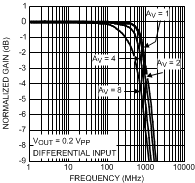 Figure 1. Frequency Response vs Gain
Figure 1. Frequency Response vs Gain
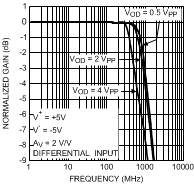 Figure 3. Frequency Response vs VOUT
Figure 3. Frequency Response vs VOUT
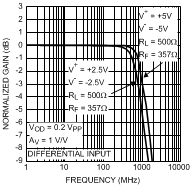 Figure 5. Frequency Response vs Supply Voltage
Figure 5. Frequency Response vs Supply Voltage
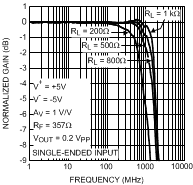 Figure 7. Frequency Response vs Resistive Load
Figure 7. Frequency Response vs Resistive Load
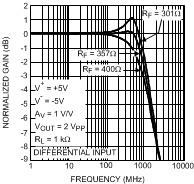 Figure 9. Frequency Response vs RF
Figure 9. Frequency Response vs RF
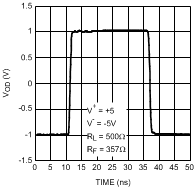 Figure 11. 2 VPP Pulse Response Single Ended Input
Figure 11. 2 VPP Pulse Response Single Ended Input
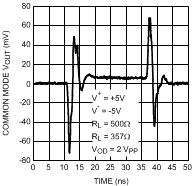 Figure 13. Output Common Mode Pulse Response
Figure 13. Output Common Mode Pulse Response
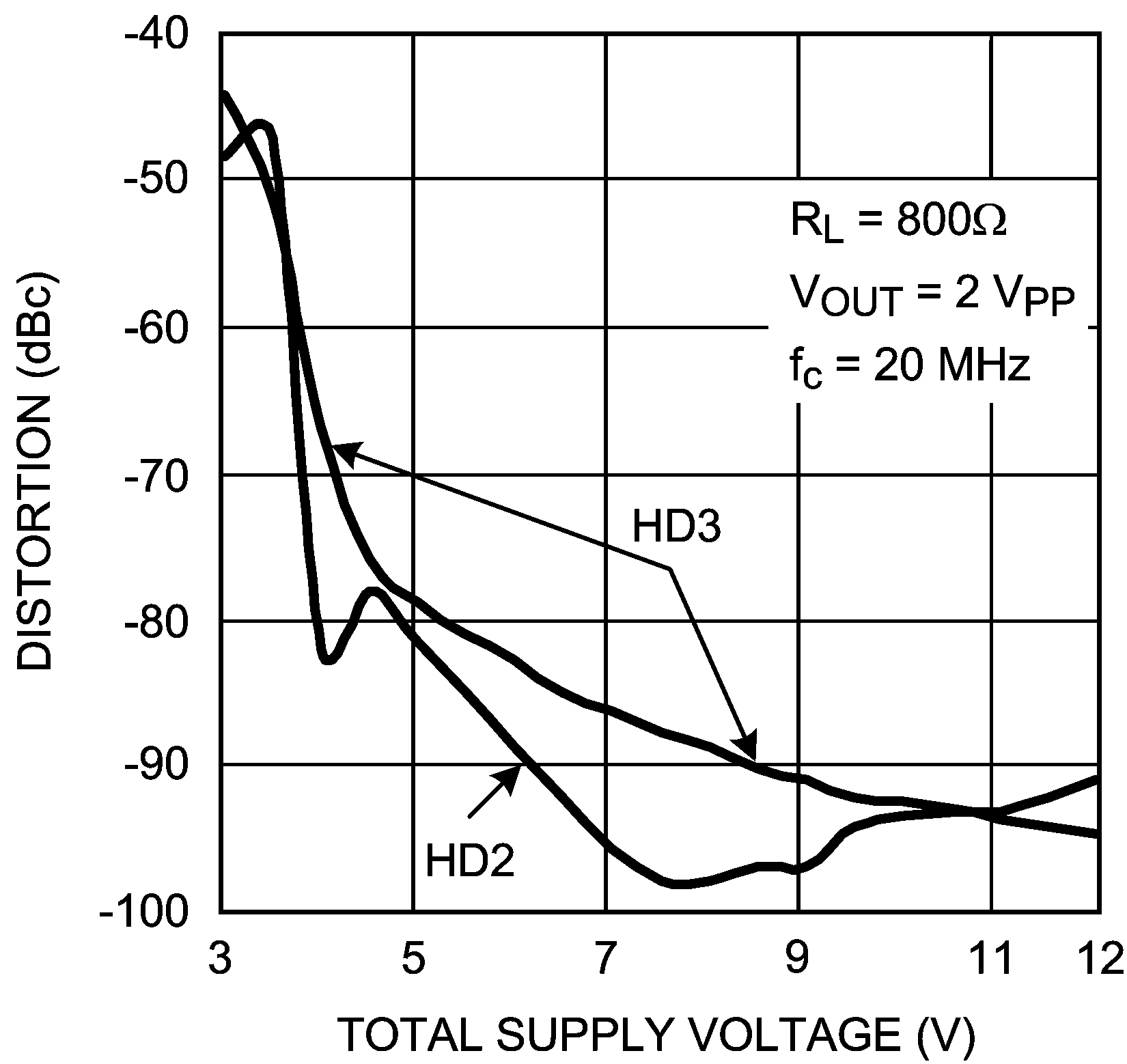 Figure 15. Distortion vs Supply Voltage
Figure 15. Distortion vs Supply Voltage
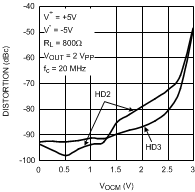 Figure 17. Distortion vs Output Common Mode Voltage
Figure 17. Distortion vs Output Common Mode Voltage
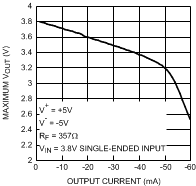 Figure 19. Maximum VOUT vs IOUT
Figure 19. Maximum VOUT vs IOUT
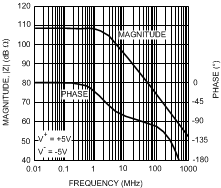 Figure 21. Open Loop Transimpedance
Figure 21. Open Loop Transimpedance
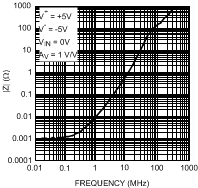 Figure 23. Closed Loop Output Impedance
Figure 23. Closed Loop Output Impedance
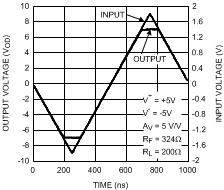 Figure 25. Overdrive Recovery
Figure 25. Overdrive Recovery
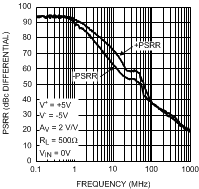 Figure 27. PSRR
Figure 27. PSRR
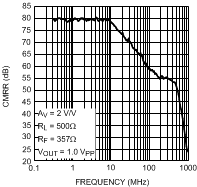 Figure 29. CMRR
Figure 29. CMRR
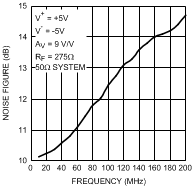 Figure 31. Noise Figure
Figure 31. Noise Figure
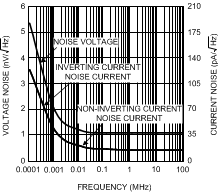 Figure 33. Input Noise vs Frequency
Figure 33. Input Noise vs Frequency
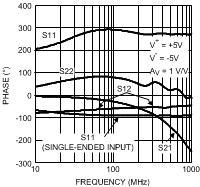 Figure 35. Differential S-Parameter Phase vs Frequency
Figure 35. Differential S-Parameter Phase vs Frequency
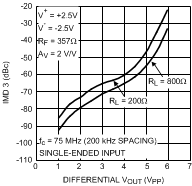 Figure 37. 3rd Order Intermodulation Products vs VOUT
Figure 37. 3rd Order Intermodulation Products vs VOUT
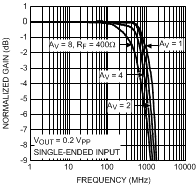 Figure 2. Frequency Response vs Gain
Figure 2. Frequency Response vs Gain
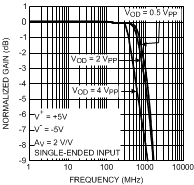 Figure 4. Frequency Response vs VOUT
Figure 4. Frequency Response vs VOUT
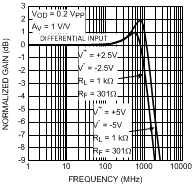 Figure 6. Frequency Response vs Supply Voltage
Figure 6. Frequency Response vs Supply Voltage
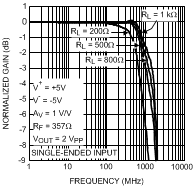 Figure 8. Frequency Response vs Resistive Load
Figure 8. Frequency Response vs Resistive Load
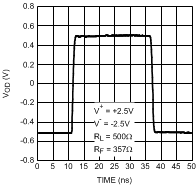 Figure 10. 1 VPP Pulse Response Single Ended Input
Figure 10. 1 VPP Pulse Response Single Ended Input
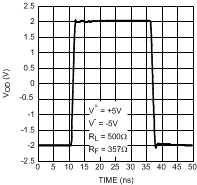 Figure 12. Large Signal Pulse Response
Figure 12. Large Signal Pulse Response
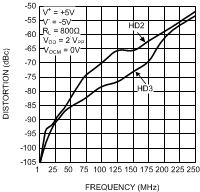 Figure 14. Distortion vs Frequency Single Ended Input
Figure 14. Distortion vs Frequency Single Ended Input
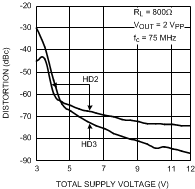 Figure 16. Distortion vs Supply Voltage
Figure 16. Distortion vs Supply Voltage
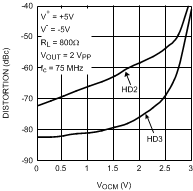 Figure 18. Distortion vs Output Common Mode Voltage
Figure 18. Distortion vs Output Common Mode Voltage
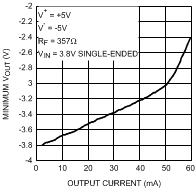 Figure 20. Minimum VOUT vs IOUT
Figure 20. Minimum VOUT vs IOUT
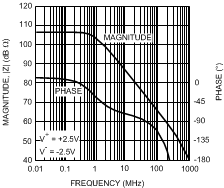 Figure 22. Open Loop Transimpedance
Figure 22. Open Loop Transimpedance
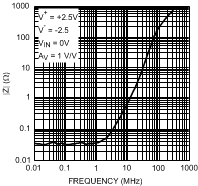 Figure 24. Closed Loop Output Impedance
Figure 24. Closed Loop Output Impedance
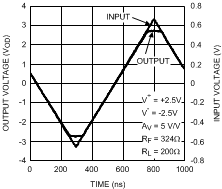 Figure 26. Overdrive Recovery
Figure 26. Overdrive Recovery
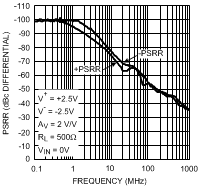 Figure 28. PSRR
Figure 28. PSRR
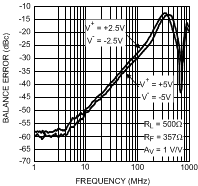 Figure 30. Balance Error
Figure 30. Balance Error
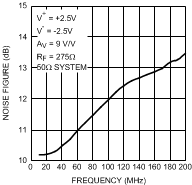 Figure 32. Noise Figure
Figure 32. Noise Figure
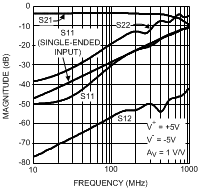 Figure 34. Differential S-Parameter Magnitude vs Frequency
Figure 34. Differential S-Parameter Magnitude vs Frequency
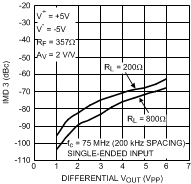 Figure 36. 3rd Order Intermodulation Products vs VOUT
Figure 36. 3rd Order Intermodulation Products vs VOUT
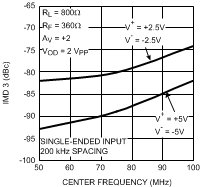 Figure 38. 3rd Order Intermodulation Products
Figure 38. 3rd Order Intermodulation Productsvs Center Frequency